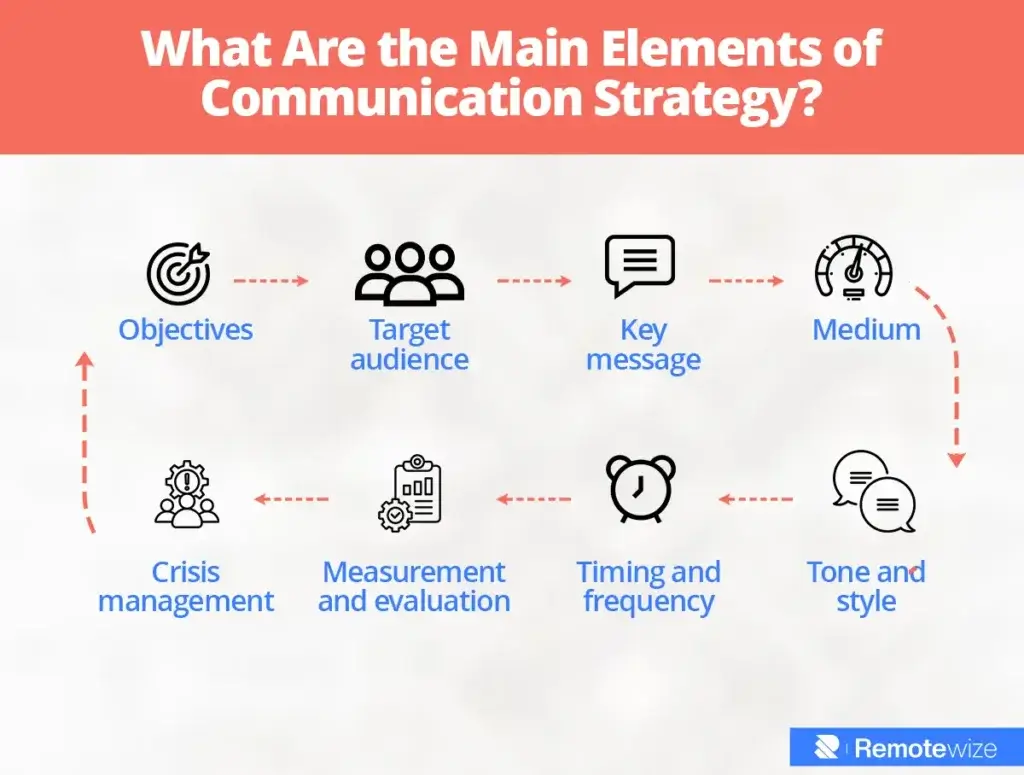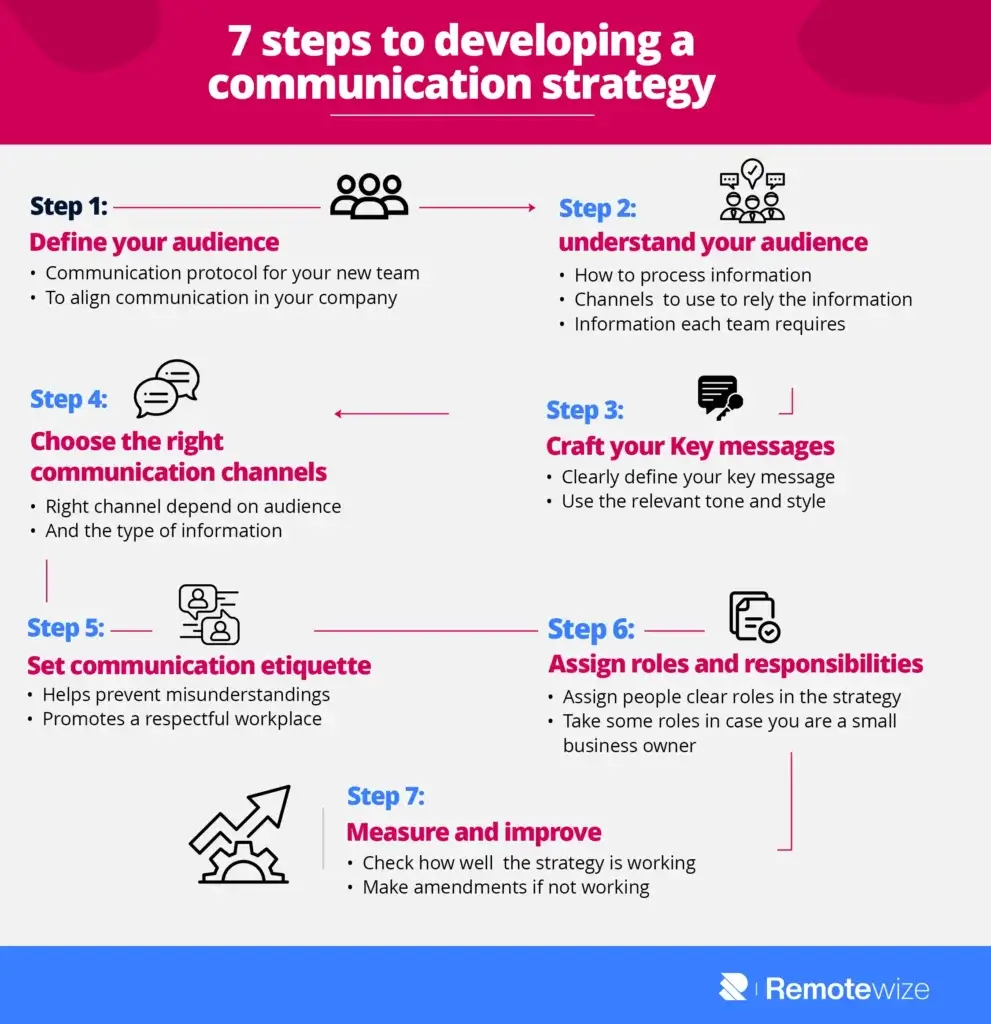Teams are spoiled for choice when it comes to communication—there’s email, social media, video conferencing, and chat apps, among others. However, having a plethora of options isn’t necessarily a good thing in remote work. With multiple points of contact, it’s easy for messages to get lost or misunderstood. This is why having a communication strategy is more important than ever in 2026.
A strong communication strategy helps make sure that your message reaches the right people at the right time in the right channel. This will allow you to keep your team aligned and your stakeholders engaged in a fast-paced, constantly-evolving business landscape.
By taking the time to develop a strategic internal communication plan, you can build trust, prevent confusion, and keep everyone on the same page. In this article, I will explain what a communication plan is and show you how to make one that works.
Key Takeaways: Communication Challenges In The Workplace
- A clear communication strategy reduces confusion: Workplace misunderstandings usually arise when there are inconsistent updates or unclear messaging. A solid strategy ensures that everyone is on the same page.
- Knowing your audience is essential: Different audiences may have different communication expectations or preferences. Tailoring your approach based on the needs helps reduce friction and ensure messages are received on time.
- Tracking and adjusting your strategy makes communication effective: You may never know if the communication strategy is not working if you don’t measure. Reviewing feedback and engagement regularly helps you fix gaps and keep your team connected.
What is a Communication Strategy?
A communication strategy is a plan that details how an organization, team, or person will share information with others. This plan defines what needs to be said, who needs to hear it, when and how it shall be delivered, and the outcome expected.
The ultimate goal for such a strategy is to ensure that messages are clear, consistent, and aligned with overall objectives. You can use a communication strategy for internal project updates, policy changes, and fostering company culture.
However, the end goal is to avoid confusion and keep everyone in the loop. It also helps build trust, manage expectations, and support better decision-making across all levels of an organization.
What Are the Main Elements of Communication Strategy?

A strong communication strategy is like a puzzle—each piece represents a key element that must fit together to create a clear, cohesive message. When aligned, they ensure your communication is not only heard but also understood and acted upon. Among these key elements are:
- Objectives – This defines what you want to achieve through your communication. Some of the objectives can be improving engagement, informing, changing behavior, or raising awareness. You can combine several objectives into one internal communication strategy.
- Target Audience – A good communication strategy targets a specific audience or set of audiences. You can have a primary audience or a secondary audience. The different audiences may have varying experiences and expectations of you.
- Key Messages – What are the main points that you want your audience to remember? These points should be clear, consistent, and aligned with your goals.
- Medium – These are the platforms you will use to deliver your messages. They can be on official or non-official platforms. You select channels based on where your audiences are most active.
- Tone and Style – The nature of the audience and what you want to communicate will determine the tone and style. These messages should resonate with the audience and still align with your brand voice.
- Timing and Frequency – This is a schedule for when and how often you share messages. Ideally, you should maximize the impact of these messages without overwhelming the audience.
- Measurement and Evaluation – You should have metrics and methods to assess the effectiveness of communication efforts. Check out the engagement rates or use feedback surveys.
- Crisis Management – Things may not always turn out as planned. Create a proactive approach to handling unexpected issues. This ensures there is quick and transparent communication in challenging situations.
Why is Communication Strategy Important?
A clear communication plan helps people and organizations share information in a way that is clear, organized, and focused. Sending out messages without a plan is likely to cause missed opportunities, low engagement, or misunderstandings. Here is why a communication strategy is essential:
- Consistency and Clarity – A good communication strategy ensures that your messages are clear and delivered the same way across various channels. This prevents mixed signals or confusion.
- Stronger Internal Communication – It helps teams stay connected and aligned with goals. This, in return, boosts productivity and trust within the organization.
- Better Decision-Making – People can make better and faster decisions when they have the right information at the right time.
- Efficient Use of Resources – A clear plan ensures that teams don’t waste time on ineffective messaging. This boosts productivity and ensures that messages reach the targeted audience on time.
- Trust and Credibility – A good strategy builds and maintains trust with employees.
- Measurable Results – Allows organizations to track performance and adjust strategies based on data. This ensures continuous improvement.
- Crisis Preparedness – Provides a structured approach to managing unexpected challenges to mitigate negative impact on employee morale or company reputation.
7 Steps to Developing a Communication Strategy

Creating a communication strategy may sound complex. However, it becomes much easier when you break it down into clear steps. Whether you are running a small business or managing a growing team, following a simple process can help you stay focused, deliver your message effectively, and build stronger connections.
Here is a step-by-step guide to help you develop a communication strategy that works.
1. Define Your Objectives
The first thing you need to do is identify what you want to achieve with your communication efforts. Are you looking to develop communication protocols for a new team? Perhaps your goal is to increase team alignment within your company?
Whatever your objectives may be, make sure to keep them specific, measurable, and aligned with broader business goals. For example, if you are looking to implement changes in company processes, determine how you’ll communicate timelines, expectations, and new workflows across departments.
Zeroing in on your objectives will guide the rest of the strategy. Once you have identified your goals, rank them in order of priority. This provides a clear benchmark for evaluating your communication plan later.
2. Understand Your Audience
Knowing what message to communicate is not enough. You must also know who they are talking to.
When communicating with your team, you have to understand how they process information and identify the best channels to relay information to them. It’s also important to assess the types of information that each team might need.
Say, for instance, your company is rolling out a new project management platform to its global remote teams. The IT department may want technical documentation. Marketing teams, on the other hand, may need a quick-start guide and visual tutorials. Without knowing these differences, leadership risks sending one generic message that doesn’t meet the needs of anyone.
To tailor communication effectively, ask questions like:
- What departments are you communicating with?
- What communication channels do they use most?
- What kind of information do they need to do their job well?
- What time zones or working hours should you consider?
- What format of messages will resonate best?
Knowing these preferences helps you make messages that are timely, relevant, and easy to use. This is especially true for remote teams that rely on clarity to avoid misalignment and delays.
3. Craft Your Key Messages
Key messages are what you want your audience to remember. These should align with your overall vision and what the audience cares about. The message should be clear, concise, and consistent.
Clarity is even more critical for remote teams, as tone and intent can easily be misinterpreted.
To develop strong key messages, follow three simple steps:
- Brainstorm with stakeholders
- Refine for clarity and tone
- Test and update regularly
Moreover, try to ask these questions:
- What’s the core message?
- Why should it matter to the team?
- What should the team do with this information?
Each message should be concise, consistent, and easy to repeat.
The abovementioned aside, make sure to use plain language, avoid jargon, and stay focused on the audience when crafting these messages. Stick to 1 to 3 key messages and support them with examples or context when needed. Remember that a strong message should motivate, guide, and build trust across your organization.
4. Choose The Right Communication Channels
Communication channels are increasing day by day. You can use emails, intranet, chat tools, internal memos, phone calls, and more. That said, you need to be strategic with your communication channels to avoid communication overload.
Remember, the right channels depend on where the audience is and how they like to receive information. It’s important to match the message to the medium. For example, a product team working across time zones may use Slack for daily standups, Zoom for weekly planning meetings, and ClickUp or Asana for task tracking.
By setting communication expectations and protocols early on, you can ensure that important updates don’t get buried or shared in the wrong place. In turn, teams can effectively prevent missed deadlines or duplicated work.
5. Set Communication Etiquette
Organizations should establish clear etiquette guidelines for how employees are expected to communicate day-to-day. These rules help prevent misunderstandings, maintain professionalism, and promote a respectful workplace.
For example, employees should know whether video cameras are expected to be on during virtual meetings, how quickly they should respond to Slack or email messages, and when it’s appropriate to call versus send a message. You might also clarify expectations around tone. For instance, whether communication should be formal, casual, or somewhere in between.
Here are a few sample etiquette guidelines to consider:
- Use “away” or “do not disturb” statuses to signal availability in chat apps.
- Reply to emails within 24 hours unless marked as urgent.
- Avoid using all caps or overly informal language in professional messages.
- Respect time zones when scheduling messages or calls for distributed teams.
Setting these norms helps employees feel more confident and reduces miscommunication.
6. Assign Roles And Responsibilities
Even the best communication plan will fall apart without clear roles. Assign people to handle different parts of the strategy. For instance, there should be people in charge of writing content, designing visuals, scheduling posts, or collecting feedback.
You can have roles like:
- Message Strategist – responsible for aligning messages with organizational goals and determining what needs to be communicated and when.
- Content Developer – crafts and edits internal messages such as company updates, CEO memos, or team newsletters in a voice that reflects the organization’s tone.
- Channel Manager – ensures the right tools are being used, messages are being published on time, and feedback loops are monitored.
If you are a small business owner, you might take on several roles yourself, but it is still ideal to clarify who does what.
7. Measure And Improve
Once your communication strategy is up and running, you need to check how well it is working. Look at metrics that match your goals, like task completion rates, project turnaround times, employee satisfaction, and cross-team collaboration effectiveness. Don’t just collect data but review it regularly and check for insights.
For instance, a noticeable drop in missed deadlines, reduced back-and-forth clarifications, or improved participation in team check-ins can signal that communication is becoming more efficient. If something is not working and you get low engagement or confusion among staff, then it is a signal to tweak your messages, timing, or channels.
For business owners, this step is crucial to scale the company and refine operations. After all, successful companies usually thrive as a result of thoughtful internal monitoring and constant improvements.
Conclusion: Turn Strategy Into Action
Developing a good communication strategy may seem like an uphill task for beginners. However, when you break it down into clear, manageable steps, it becomes much easier. It is ideal that you remain intentional in a world where you receive messages across emails, team chats, and more.
Each part of the process plays a critical role, from setting clear objectives and understanding your audience to drafting the key messages and choosing the right channels.
Strong internal communication keeps your team aligned, encourages collaboration, and improves overall team performance. While no strategy is flawless from the start, regularly measuring its impact and making essential adjustments and improvements ensures it continues to meet the needs of your organization.
When you communicate with purpose and clarity, you don’t just avoid confusion but also create a connection.
FAQs: Communication Strategy
What are the types of strategic communications?
The main types include internal, external, crisis, and marketing communication. Each type serves a different purpose but works together to support the overall strategy
What are the main components of a communication strategy?
The key components are objectives, target audience, key messages, communication channels, timing, tone, and evaluation. These elements help ensure your message is clear, consistent, and aligned with your goals.




